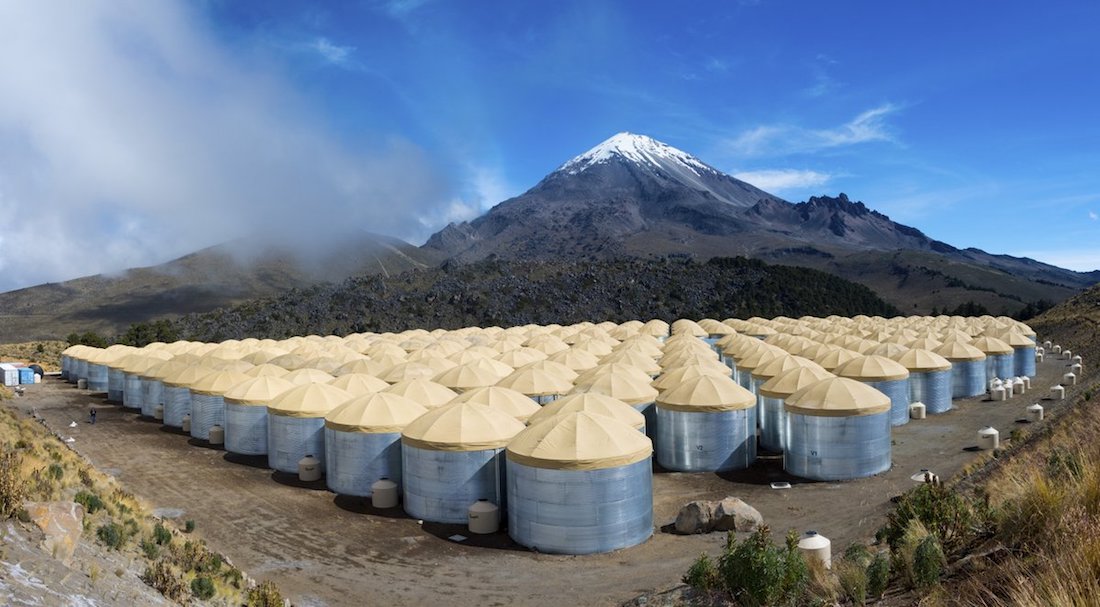IFIC researcher Francisco Salesa Greus, along with other members of the HAWC collaboration, have detected very high-energy photons from a galactic source that could be the candidate to produce cosmic rays. The detection of neutrinos through telescopes such as KM3NeT or IceCube would confirm the study. This finding has been published in The Astrophysical Journal Letters.
HAWC is a gamma ray observatory located in Mexico that allows the collection of information on the most violent phenomena that occur in the universe. Gamma rays are produced in very energetic astrophysical phenomena, such as supernova explosions or nuclei of active galaxies and are made up of high-energy photons that when they come into contact with the Earth’s atmosphere are absorbed, which makes their observation difficult.
The analysis, led by Salesa, a researcher at the Institute of Corpuscular Physics (UV-CSIC), shows the detection of high-energy photons from a galactic source, HAWC J1825-134, whose spectrum continues uninterrupted up to levels of at least 200TeV, which would imply that this emission should have been created by even more powerful cosmic rays, on the order of petaelectronvolt (PeV), which shows a possible origin of these. In fact, there are more than 200 gamma ray sources that emit at energies of teraelectronvolts (TeV); but sources that emit more than 100TeV there are less than a dozen confirmed.
According to this study, the gamma rays observed by HAWC would be the result of the interaction of cosmic rays of higher energy with the molecules of a zone of high density of matter, a molecular cloud.
The result of being before one of the most powerful cosmic ray sources discovered so far could be confirmed with the detection of neutrinos from HAWC J1825-134 using neutrino telescopes such as KM3NeT or IceCube. This source stands out for being in an ideal position to be observed by the future KM3NeT.
“The results of the HAWC J1825-134 observations make this source a clear candidate for emitting high-energy neutrinos”, says Francisco Salesa. With a telescope of the detection volume of KM3NeT it is expected to be able to observe this source during the period of operation of the detector. “HAWC J1825-134 has the advantage of being located in the southern celestial hemisphere, which is the part of the sky where KM3NeT is most sensitive”, adds Salesa.
KM3NeT and IceCube telescopes
KM3NeT located at the bottom of the Mediterranean Sea and IceCube, located at the South Pole, are detectors for neutrinos, the smallest uncharged subatomic particles known to date. Regarding this research, both telescopes will work to confirm the results obtained by HAWC, in the event that the expected emission of neutrinos is observed as a product of the interaction of high-energy cosmic rays with matter and radiation at the source of production.
The KM3NeT detector, in which the IFIC participates actively, is currently under construction and already has several operational detection lines. KM3NeT is expected to be fully operational in the next few years.
Francisco Salesa, Distinguished Researcher of the GenT program of the Department of Innovation, Universities, Science and Digital Society of the Valencian Government, focuses his work mainly on Multi-Messenger Astronomy, which aims to study the astrophysical phenomena observed by different astroparticle detectors in spatial and / or temporal coincidence. Thus, even with little statistics it can be reliably affirmed that these events occurred in the same cosmic source and extract important information about the nature of the most energetic accelerators in the universe.
Reference:
Evidence of 200 TeV Photons from HAWC J1825-134. A. Albert, R. Alfaro, C. Alvarez, J. R. Angeles Camacho, J. C. Arteaga-Velázquez, K. P. Arunbabu, D. Avila Rojas, H. A. Ayala Solares, V. Baghmanyan, E. Belmont-Moreno et alii . The Astrophysical Journal Letters.
https://doi.org/10.3847/2041-8213/abd77b


